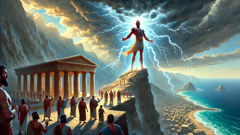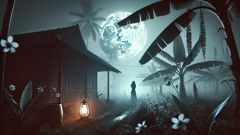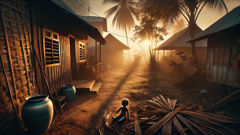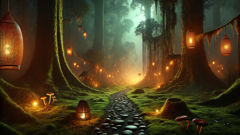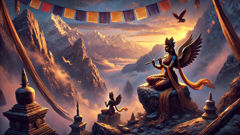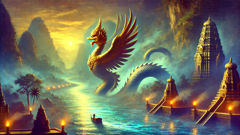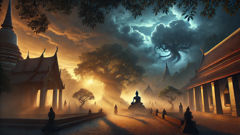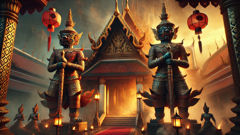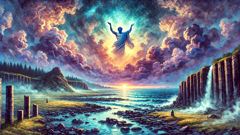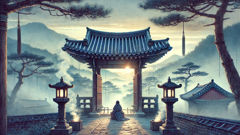Introduction
On the sun-baked coasts of ancient Syria, where the white limestone cliffs of Ugarit stare into the endless blue expanse of the Mediterranean, the winds once carried tales that shaped a civilization. Long before the written word bound myth to parchment, the Baal Cycle unfurled beneath the gaze of highland oaks and sacred cedars, its echoes riding on thunderheads and the rhythmic crash of waves. The people of Ugarit raised their eyes skyward and watched as lightning split the clouds, believing it was Baal, the Lord of Storms, wielding his power. Each deluge that awakened the parched earth, each tempest that shattered the quiet night, was more than mere weather—it was divine drama, the living heartbeat of a world where gods and mortals were never far apart.
In the Baal Cycle, the boundaries between nature and deity dissolve. Baal is not only storm but also life itself, the axis upon which hope and harvest depend. His world is peopled by divine rivals—Yamm, the Sea, whose wrath threatens to swallow creation; Mot, Death incarnate, whose hunger is eternal; Anat, the fierce goddess whose love and rage shape destinies. These stories are more than epic battles or cosmic feuds; they are the pulse of ancient Canaan, a reflection of people struggling to make sense of chaos and order, drought and abundance, mortality and renewal. The Baal Cycle is a journey into the very heart of myth, where every flash of lightning and every roll of thunder recalls a time when gods walked among men and the fate of the world hung in the balance.
I. The Rise of Baal: Storm on the Sacred Mountain
At the dawn of all things, when mountains still dreamed and the sea’s song was young, the gods gathered in the golden halls of El, Father of Years. In those days, the world teetered between silence and storm, and mortals gazed upwards, craving the blessing of rain. Among the children of El, none were as restless as Baal-Hadad—the Storm-Bringer, Lord of the Heavens. His eyes were shards of obsidian lightning, and in his fist he held a club that could shatter mountains. To his people, Baal was promise incarnate: of the sky opening to pour life onto the thirsty fields.
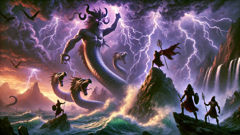
Yet the throne at the heart of the gods’ domain was not his. It belonged to El, ancient and wise, who presided over the pantheon with a slow, inexorable patience. The other gods—resplendent Dagon, nurturing Asherah, cunning Shapash the sun—circled around their father, each nurturing hopes, fears, and ambitions. But in the depths of Baal’s heart, a storm gathered, for he knew that power must be claimed, not merely inherited.
The world, too, waited. Ugarit’s people scrawled prayers onto clay tablets, their supplications rising like smoke from cedar fires. They longed for rain, for fertility, for the land to awaken from its slumber. But their pleas often met silence. The seasons grew harsh; crops withered. In the silence of the dry months, whispers spread: had Baal lost his favor? Did another power lurk beneath the shimmering surface of the sea?
It was then that Yamm—god of the untamed Sea—rose to challenge Baal. Yamm’s voice was the deep roar of waves smashing rock. He sent messengers to El’s council, demanding dominion over all creation. His messengers—dragon-bodied Lotan and the twin monsters—struck terror into gods and mortals alike. The council trembled, but Baal stood. His voice split the tension like thunder: "Why should the waters claim what belongs to sky and earth? I will not yield."
Thus began the first great battle. On the sacred mountain, beneath clouds churning with expectation, Baal called Anat, his fierce and loyal sister. "Will you fight with me?" he asked. Anat’s eyes flashed. "Let Yamm come. I’ll scatter his bones to the four winds."
The air shimmered with anticipation as Baal armed himself. His club, forged from ancient cedar and iron, hummed with latent power. Anat girded herself in armor of bronze and silver. The ground shook as Yamm’s monstrous forms slithered up from the depths, scales glistening, jaws wide.
Baal struck first. Lightning leapt from his hand, searing the sky and boiling the sea’s surface. Yamm lashed out with tidal fury, summoning whirlpools and monstrous waves. The gods above watched, helpless. The people below, huddled in their homes, felt the thunder as a promise and a threat.
The battle raged for seven days. Baal was battered but unbroken. Each strike of his club shattered a new wave; each flash of lightning split the darkness. With Anat at his side, fierce and unyielding, Baal pressed the attack. At last, he raised his club for a final blow. The sky itself seemed to pause.
With a cry that echoed from mountain to shore, Baal brought his weapon down upon Yamm. The sea god reeled, his monsters shrieking. The earth trembled as Yamm was cast down, broken and defeated, his dominion shattered. The sky cleared; rain fell in sheets upon the grateful land. Baal had triumphed—not only over Yamm, but over drought and despair.
The gods gathered once more. El, smiling with ancient pride, welcomed Baal into the great hall. "You have proven yourself, my son. The world is yours to command."
Yet power brings new trials. As Baal ascended his throne atop Mount Saphon, crowned with lightning, a new shadow stirred on the horizon. For in the underworld, Mot—Death itself—watched with cold, patient hunger, knowing that all things, even gods, must one day yield to his embrace.
II. The Palace of Baal: Triumph, Glory, and the Shadow of Death
With Yamm vanquished and the land blessed by rain, Baal’s name was sung in every corner of Ugarit. The fields greened, olives swelled on twisted branches, and rivers overflowed their banks. Yet in the heart of the storm god burned a longing—not only to rule, but to establish a home worthy of his power. “All gods have their palaces,” he declared to Anat. “Why do I have none?”
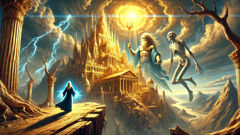
His plea reached Asherah, Mother of the Gods, whose wisdom was both deep and dangerous. She agreed to intercede with El. After much entreaty and counsel, El relented, and Baal’s palace was to be built atop Mount Saphon, so high it scraped the clouds. Craftsmen divine—Kothar-wa-Khasis, the ingenious artisan—set to work with stone and gold and cedar beams. The palace rose, shining in the sun and glowing by moonlight, its gates wide as the horizon.
On the day of dedication, Baal’s feast echoed through the heavens. Musicians played lyres and drums; priests poured wine; dancers spun in wild celebration. Baal strode through his halls, his robe flashing blue and silver, his scepter radiant with storm-light. Anat, always at his side, laughed with joy. Even El nodded in approval. The world seemed whole.
But glory has a price. In the depths below, Mot—the god of Death—stirred. Where Baal brought rain and life, Mot brought drought and decay. His palace was a pit of shadows, a banquet hall of dust and bones. Mot’s hunger knew no bounds, for all that lives must come to him in time.
Mot sent word to Baal: “Come to my table. Bow before Death as you bowed before Sea.” Baal hesitated. Anat’s eyes narrowed. “You are not like Yamm,” she warned. “Mot’s power is cold, and his patience is endless.” Yet Baal, prideful and bold, sent a reply that bristled with defiance.
Mot’s anger was slow but inexorable. He sent drought to wither Baal’s fields; a hush fell over the streams. The people of Ugarit watched their crops wither and asked—where is Baal now? Clouds gathered but brought no rain. In their temples, priests wept and wailed.
Unable to ignore Mot’s summons, Baal descended to the underworld. The gates yawned open to swallow him, and he walked into darkness. Mot greeted him with a smile like cracked bone. “Eat my bread of dust; drink my wine of mud,” he intoned. Baal’s strength faltered. In that place of gloom, he was no longer storm or thunder—only a lost soul in Death’s dominion.
Above, the world mourned. Even Anat’s sword seemed powerless. She searched for her brother, calling his name across the mountains and fields. But Baal did not answer. The rains stopped entirely; a great silence settled on the land. Shapash, the sun goddess, cast pale rays over barren fields. Hope faded from Ugarit’s people.
But Anat was not a goddess who accepted loss. Her love for Baal burned with the heat of a thousand summers. She descended into the underworld, sword in hand. No guardian could bar her way. She found Mot in his hall and struck him down—scattering his bones, grinding his skull to dust. With a cry that split the darkness, Anat seized Baal’s battered form and dragged him back toward the light.
Shapash, seeing Anat’s struggle, poured sunlight onto the shadowed path. Slowly, Baal’s spirit revived. Rainclouds gathered on the horizon once more. With Anat’s fierce devotion and Shapash’s unwavering light, Baal emerged from Death’s grasp. The land shuddered and awakened—rivers flowed, olives ripened, and the people rejoiced again.
Mot, however, was not destroyed. From dust and shadow he re-formed, for Death cannot die. But Baal had learned that power is not eternal, and even gods must face darkness. The cycle would repeat: life, death, storm, drought—each season a turning of the wheel that bound mortals and gods together.
III. The Eternal Return: Storms, Seasons, and the Heartbeat of Ugarit
As years unfolded and generations came and went, the people of Ugarit found themselves enacting the Baal Cycle in every aspect of their lives. They watched for signs in the sky—clouds gathering, winds shifting—wondering if Baal’s favor would return or if Mot’s hunger would prevail. The cycle of rain and drought was no longer just weather; it was a living myth that shaped their choices and hopes.
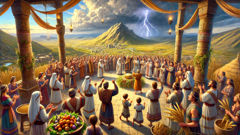
In springtime, when the first distant thunder rolled over Mount Saphon, farmers knelt in the fields, offering barley and figs to Baal. Children danced as fat drops pattered on sun-baked earth. Priests led processions to the temples, raising their voices in song: “Baal returns! Life returns!” At every harvest festival, ancient hymns retold Baal’s descent and resurrection, binding each new crop to the fate of their storm god.
But as autumn’s chill crept over the hills and riverbeds dried, anxiety returned. The people whispered stories in the flickering firelight: “Mot has claimed Baal again. Will rain ever come?” In the silence of drought, they recalled Anat’s fury and Shapash’s hope—reminders that death was never final, that devotion and courage could wrest life from even the deepest darkness.
The great temples of Ugarit became more than places of worship; they were theaters where myth played out in ritual and song. Clay tablets bearing the stories of Baal and his rivals were etched and stored, preserving the cycles for future generations. Young scribes learned to shape cuneiform symbols, copying lines that told of storms, seas, and underworlds. Each word was a prayer—a hope that Baal would rise again.
Beyond Ugarit’s walls, traders carried these tales across mountains and deserts: to Egypt, where Ra’s sun boat sailed above; to Mesopotamia, where Enlil stirred storms; even to Greece, where Zeus’s thunder echoed Baal’s own. The Baal Cycle’s resonance grew, weaving itself into the tapestry of Mediterranean myth.
In every telling, Baal became more than a storm god—he became the pulse of the land itself. His struggles with Yamm and Mot mirrored the challenges every mortal faced: chaos, loss, renewal. The people saw their lives reflected in the drama of gods: crops failing and reviving, families mourning and rejoicing, hope flickering and flaring anew.
So, as thunder rolled and rain swept over ancient Ugarit, the story endured. Baal’s legend became both shield and beacon—a reminder that storms would come but would also pass; that death would claim, but life would rise again; that courage and love could illuminate even the darkest season. And beneath the watchful eyes of mountains and sea, the heartbeat of myth continued—eternal, unbroken, alive.
Conclusion
The Baal Cycle is more than a tale of gods clashing in the heavens—it’s a living echo of humanity’s quest for meaning amid uncertainty. The people of Ugarit found hope in Baal’s thunder, solace in Anat’s devotion, and wisdom in the cycle of rain and drought. These myths are not relics but living memories, reminders that all creation is caught in cycles of loss and return, darkness and dawn. In every season’s change, in every hope for rain or fear of drought, the heartbeat of Baal’s legend endures—a timeless testament to courage, resilience, and the enduring power of myth to bind people to the world around them and to each other.

